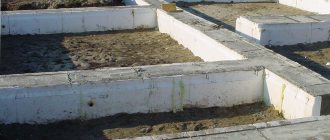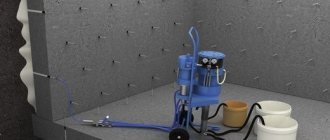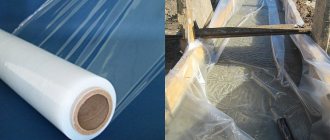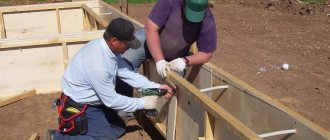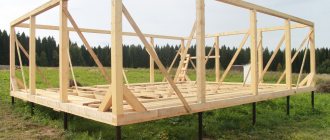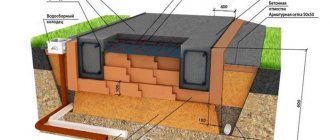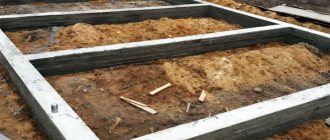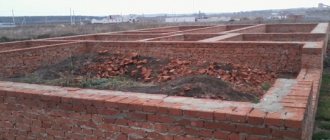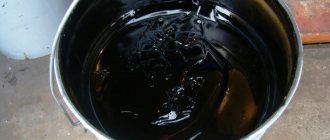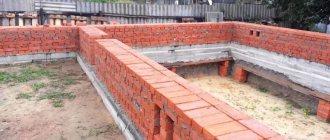Advantages of using film as waterproofing
The use of film for waterproofing foundations has many positive aspects. Due to its characteristics, this material has excellent protective insulating properties, as well as other advantages, such as:
- Resists moisture and mold
- The surface has a corrugated base, which helps to prevent the material from moving away during its installation.
- The material is not subject to rotting and decomposition processes
- Thanks to its flexible properties, it is very easy to install
- Low material cost
Application of profiled waterproofing materials
The sheet is laid out with the protrusions outward, and geotextiles are spread on top of it. As a result, artificial channels are formed between the surfaces, connected to the drainage system of the house. Thus, groundwater or condensate formed is removed from the surface of the film without interference, without causing harm to it. More expensive membrane models have a combined structure, where geotextiles are simultaneously used as an external filler.
Membranes can also be used as an element of multilayer waterproofing systems. In such cases, it perfectly protects the layer of bitumen mastic or roofing felt from mechanical damage, and improves water drainage even during flash floods. But before installing them, you need to make a high-quality drainage system with a water drainage complex.
Disadvantages of using film as waterproofing
In addition to the advantages, the use of such material also has its disadvantages, which include:
- The film coating is very susceptible to ultraviolet rays. In an open space, it quickly becomes unusable and loses all its protective functions. Therefore, its service life in such conditions is a maximum of one year.
- Its integrity can easily be damaged during installation, which negates the entire process and functions of waterproofing. Therefore, when using this material, you should additionally secure the place where it will be placed.
- It can easily be damaged by rodents. In view of this, you should not keep it within their reach.
Distinctive features of a waterproofing membrane for foundations
Bitumen, roofing felt and roofing felt protective agents have been replaced by high-tech and at the same time easy-to-use membrane waterproofing. This modern material has long won its niche in the construction industry thanks to its excellent qualities:
- absolute waterproofness;
- ability to withstand strong water pressure;
- resistance to chemical compounds and mechanical stress;
- the ability not to lose ductility and strength during temperature changes from -60°C to +40°C;
- resistance to ultraviolet rays;
- environmentally friendly;
- resistance to corrosion.
The only disadvantage of membrane waterproofing is its high cost, but this disadvantage is compensated by the long service life of the material and ease of installation.
Types of films suitable for foundation waterproofing
The product, intended for waterproofing the foundation, can be found both from Russian and foreign manufacturers. They come in different types:
- Roll simple. Thickness varies from 0.6 millimeters to two millimeters. This type of film is widely used for household needs. In addition to waterproofing material, it is used for greenhouse and greenhouse covers. The use of such a film to cover the foundation is very inexpensive, but in order to use it, it is necessary to provide favorable conditions, since it can be damaged very easily. Manufacturers have recently begun to add special additives during the production of such films that increase the strength of the product.
- Reinforced. This kind of film product is a multilayer roll. The central layer has a non-woven base or polypropylene mesh, which is sealed between the outer layer. Perforated and non-perforated types are available in production. Films of this type differ in quality from each other. Accordingly, they cost differently on the construction market. The perforated layer has small micro-holes that are responsible for the passage of moisture. This type of film is mainly used for waterproofing pitched roofs. The non-perforated type, on the contrary, does not allow moisture to pass through. And the reinforcing cover protects the film from deformation, which increases its service life. Reinforced film, designed for waterproofing roofing surfaces and foundations, is produced in the form of rolls and has a different color range. When purchasing, you need to consider the surface density of the film, not its thickness. Thus, it is best to choose a film density from one hundred to two hundred and fifty g/m2.
- Diffusion membranes. They have multiple layers. They have the ability to transmit hydroid steam, but are also waterproof. This film is widely used in roofing construction due to its ability to remove steam from the heat-insulating layer to the outside, which performs protective functions against destruction and rotting. Superdiffusion film has found its application in areas that are known to be damp. They can be saunas, kitchens, cafes and restaurants. The cost of these two types differs little from each other. Therefore, it makes sense to choose the latter type for waterproofing, while providing yourself with a guarantee of reliability, even if the film product is suddenly damaged during laying.
Film (polymer) membrane
This material is usually produced with a smooth surface and corrugated (for more dense adhesion of dissimilar surfaces). The film is made in wide rolls, which allows you to cover the largest possible surface without connecting seams. The thickness of the sheet is 1.5-2 mm.
There are three types of film membrane:
- TPO – reinforcing mesh covered with thermoplastic;
- EPDM – rubber predominates in composition;
- PVC – made from polyvinyl chloride.
When waterproofing foundation slabs, PVC membrane is most often chosen due to its low cost and a number of advantages. The two-layer membrane consists of limestone, fire retardants and a plasticizer on one side, and on the other side it is covered with a painted PVC film of varying densities. The painted side is a signal; the color change helps to quickly determine the location of film damage and eliminate it. The thickness of the coating depends on the depth of the foundation being laid.
The PVC membrane is quite easy to install, because continuous gluing to the base is not required. It is enough to fasten the seams with a technical hair dryer; the film does not burn when heated. It is not afraid of low temperatures and does not lose its plasticity, so you can work with it even in winter. Thanks to the special stabilizers included in the material, it is not afraid of ground salts, acids and alkalis.
PVC membrane is susceptible to mechanical damage and cuts. Therefore, during installation, you need to pay special attention to the surface to be protected and eliminate all sharp protrusions, since the film may tear when covered with soil and compacted.
Avoid contact of the film with fat, oil, tar, bitumen and solvent, which can reduce the protective properties of the material. To avoid this, you need to lay an intermediate material (geotextile) that will protect the film and also soften the load from external pressure.
When attaching waterproofing horizontally, layers of cushioning geotextiles must be overlapped one on top of another by 15 cm. Then a PVC membrane is laid with one sheet overlapping another by 10 cm. The joints are fastened by welding (technical hair dryer), it is important to take into account that the width of the seam should be 1.5 cm, and the air channel - at least 2 cm.
To secure the membrane to a vertical surface, spot welding with heated air is used. The concrete base is covered with geotextile and fixed with special glue. Next, PVC film is laid, the sheets of which are glued together with double-sided tape.
The process of welding PVC membranes requires compliance with certain conditions:
- before welding, you must first clean the surfaces to be bonded from dirt;
- carry out work at a temperature not lower than -15°C;
- make a test weld and check the strength of the seam after half an hour.
Film laying technique
The superficial fundamental area needs protection; for this, a waterproofing film is used.
The laying steps are as follows:
- First you need to clean the surface of the foundation from sand and other similar elements.
- Remove all protrusions, as they may cause damage to the film during its laying or during subsequent use of the structure.
- Next, a layer of the mixture is applied to the foundation. The foundation should first be moistened with water to prevent rapid absorption of water from the solution.
- The film for waterproofing the foundation is laid out on the mortar layer. The width, in this case, must be selected in such a way that the remainder of any protrusion of the foundation is at least five centimeters.
- The joining of film sheets is done with an overlap of at least thirty-five centimeters. In order to ensure a reliable connection, it is glued at the joints. For gluing, you can use special construction adhesive or sealing tape.
- Then a second layer of mortar mixture must be applied to the film product, which represents the adhesive element for laying the first row of brick or concrete.
What are these materials?
A type of profiled waterproofing material for building foundations.
This is a special film that protects the space between the sheet and the foundation from all types of moisture. This is also an excellent way to protect against mechanical stress, since the structure of the material is porous and is characterized by high elasticity and resistance to almost any aggressive environment.
It is made from high and low density polyethylene and contains antioxidants, mineral components and polymers. All fillers, depending on the structure and composition, significantly increase the performance characteristics of membranes. This is a corrugated fabric up to 3 mm thick with a porous structure; in some cases, especially with strong seasonal rises in groundwater, dense films up to 5 mm thick are used.
Advantages of waterproofing membranes:
- polyethylene is UV resistant;
- service life up to 50 years;
- the membrane is resistant to external aggressive environments and is not damaged by rodents;
- the coating is environmentally friendly and does not oxidize;
- special polymer and mineral fillers ensure constant elasticity at all ambient temperatures;
- not subject to corrosion;
- can be used in strongly acidic or strongly alkaline environments, since polyethylene is practically inert.
Modern waterproofing membranes are also worth using from an economic point of view. They are easy to install; no construction equipment is required. Types of waterproofing differ in design features:
- Lightweight moisture insulation. The main purpose is to block the flow of capillary, rainwater and natural rainwater aquifers, so it can often be found on foundations installed above the groundwater level.
- Medium and heavy waterproofing. It is used to protect against surface water seeping through the blind area or cracks in the base, vertical pressure groundwater, as well as in case of a sharp increase in water pressure (for example, during the season of heavy rains or sudden melting of snow).
You can install the coating yourself in a few days, and the speed of installation does not affect the quality of the coating.
Functions performed by waterproofing film
The film product, which is used for waterproofing foundations, performs certain functions. These are:
- Forms the basis of the waterproofing layer. Traditionally, for these tasks, a diffusion film membrane is used, which allows steam to pass through, but not water.
- For auxiliary waterproofing, polyethylene with high density and thickness is used. Its use is based on intermediate use between the soil layer and the waterproofing base, as well as between the concrete screed and insulation.
Types of waterproofing coatings
Type of profiled products for waterproofing the foundations of buildings
Membrane is already beginning to slowly displace conventional roofing felt or coating mastics from the building materials market. It is easy to use, easy to install and does not require seasonal maintenance.
Thanks to its design and good technical characteristics, it perfectly protects the foundation walls from any impact of groundwater, while not deforming over time. Main types of membranes:
- Flat film structures. They are made from polyethylene and other synthetic polymer materials, often human waste. Thus, film membranes are relatively inexpensive and have an average film thickness of 0.2–2 mm. For waterproofing bases, films with a thickness of at least 0.4 mm are used. There are also flat corrugated membranes on sale; they have a high degree of adhesion to the solution.
- Profiled membranes are made only from high-density polyethylene, have different shapes and are equipped with special protrusions. It can be single-layer or multi-layer, used exclusively to protect foundations from ground and rainwater, they can also be used as a drainage system in conjunction with geotextiles. Profiled membranes have sheet thickness up to 1 mm, projection height up to 8 mm (private use), or up to 20 mm (industrial and mine use).
Mounting options
Depending on the type of waterproofing material for the base, the installation scheme will change.
Welded, adhesive waterproofing
Step-by-step instructions for performing a protective coating on the basement floor using the method of organizing guided, adhesive waterproofing against the dangerous influence of high humidity levels:
- A primer is applied to provide an additional layer of protection. The primer is a heat insulator.
- Ball of mastic. One layer is performed. You can use varnish. Reliable adhesion of the insulating building material and the foundation is ensured.
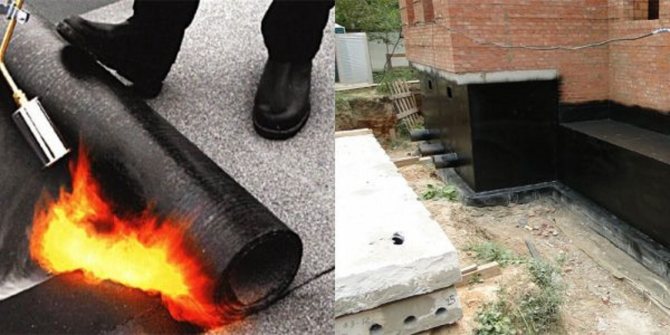
Guided, pasted
- Waterproofing material is being laid. The adhesive roll insulator is mounted in several layers. The resulting butt joints are treated with mastic. The guided type of foundation insulator is mounted with one ball, by heating with a gas burner.
- Upon completion of the work, the surface is treated with mastic and varnish.
- To protect the finished waterproofing base, it is recommended to lay thermal insulation and brick the entire perimeter.
- A blind area is being built.
Membrane waterproofing
The membrane recently appeared on the market. Differs in installation technique.
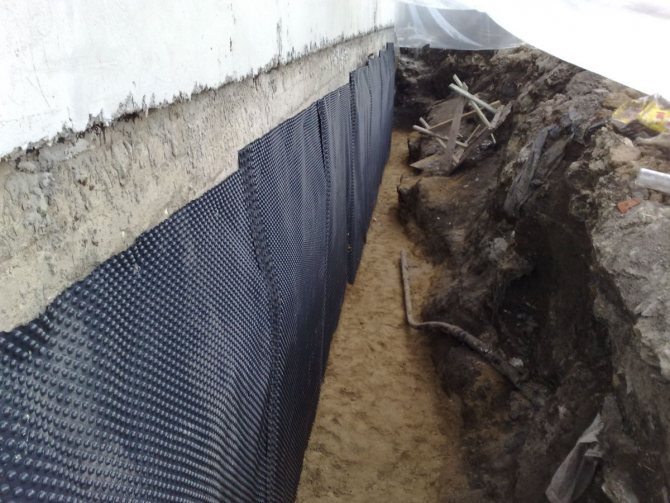
Foundation membrane insulator
Adviсe:
- protection of the vertical surface of the base of the house is carried out with a profiled membrane. The material provides protruding spikes. Promotes uniform distribution of pressure throughout the foundation of the building. The outer side of the spikes allows moisture to condense and be discharged into the drainage system;
- fastening of the profiled membrane covering is ensured by the use of PVC-coated metal products. Installation of fastenings is carried out on the surface of the base of the house. A heat gun for construction purposes is used;
- waterproofing horizontal planes requires the use of a smooth membrane. The coating prevents moisture from entering the pores of the concrete foundation. The insulating material is laid overlapping. The seams are connected using a construction heat gun.
